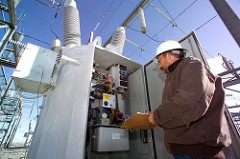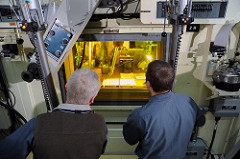 | | NUC FY17 Annual Report Now Available | 1/15/2018 | The National University Consortium's annual report for FY17 is now available.
A few highlights from the report: Three additional DOE-NE NEET and NEUP projects were awarded for a total of $2.4 million with $300,000 committed to INL. This is in addition to the 13 NUC-led projects awarded from 2013-2016, all of which included INL engagement, for a 3 year total of $18.2 million in funding with $1.66 million committed to INL. Publications increased from 73 in FY16 to 105 in the last fiscal year. Thomas Holschuh, a Ph.D. graduate from Oregon State University was hired as a Deslonde de Boisblanc Distinguished Postdoctoral Appointment. Representatives from North Carolina State University and Oregon State University were selected for leadership positions on the Versatile Test Reactor Academic Committee. One hundred fourteen undergraduate and graduate NUC students participated in INL related R&D including 37 interns. NUC engagement included work on TREAT, hybrid energy systems, materials testing, seismic risk modeling, and improvements to several MOOSE modules.
To read the full report, please go to this link: https://inlnuc.inl.gov/SiteAssets/NUC_Annual-Report_FY17_Final-2.pdf | | Edit:
|  |  | | Self-Healing Microgrids to Help Keep Cordovo, Alaska Electrified | 1/2/2018 |  In the aftermath of natural disasters, damage to an electrical grid can slow the recovery effort and prolong human suffering. Last fall, Idaho National Laboratory researchers assembled a coalition of partners to design a system of microgrids that would enhance grid resilience by maintaining and restoring power after a catastrophic event or a cyberattack. During the coming months, the partners will demonstrate this technology in the small fishing village of Cordova, Alaska. When the microgrid system is finished, Cordova’s electrical grid will automatically reroute power to ensure that critical public services — hospitals, emergency shelters and other vital services — have electricity if part of the grid is damaged or disabled. | | Edit:
|  |  | | New Technique Could Make Captured Carbon More Valuable | 12/15/2017 |  Carbon capture could help the nation’s coal plants reduce greenhouse gas emissions, yet economic challenges are part of the reason the technology isn’t widely used today. That could change if power plants could turn captured carbon into a usable product. Scientists at the U.S. Department of Energy’s Idaho National Laboratory have developed an efficient process for turning captured carbon dioxide into syngas, a mixture of H2 and CO that can be used to make fuels and chemicals. The team has published its results in Green Chemistry, a publication of the Royal Society of Chemistry. | | Edit:
|  |  | | GAIN Announces Advanced Nuclear Technology Voucher Opportunity | 12/13/2017 |  The Gateway for Accelerated Innovation in Nuclear (GAIN) today announced the availability of fiscal year 2018 funds for vouchers to assist applicants developing advanced nuclear energy technologies who are seeking access to the world-class expertise and capabilities available across the U.S. Department of Energy’s national laboratory complex. The vouchers are provided by the DOE’s Office of Nuclear Energy to support nuclear energy innovation. “We are excited to offer another round of vouchers to help support U.S. innovation in advanced nuclear technology,” said Rita Baranwal, GAIN director. “The objective of GAIN is to accelerate cost-effective commercialization of advanced nuclear energy technologies. This cost-sharing initiative enables partnerships with businesses and provides them with access to the technical, regulatory and financial support necessary to bring these important technologies to the market sooner.” | | Edit:
|  |  | | National Grid Resilience and Cybersecurity Testing Capabilities Expanded at Full Scale | 11/28/2017 |  Essential services like hospitals and water treatment depend on energy distribution to ensure reliable and continuous operations. As the power grid evolves, becoming more connected and responsive, those new, smart devices can introduce greater cyber vulnerabilities. To address this challenge, the power grid test bed at the U.S. Department of Energy’s 890-square-mile Idaho National Laboratory has been transitioned to a more adaptive architecture. This enables greater flexibility in testing new ideas and technologies to better advance innovation to protect the nation’s energy distribution systems. | | Edit:
|  |
|
Compliance Details javascript:if (typeof CalloutManager !== 'undefined' && Boolean(CalloutManager) && Boolean(CalloutManager.closeAll)) CalloutManager.closeAll(); commonShowModalDialog('{SiteUrl}'+
'/_layouts/15/itemexpiration.aspx'
+'?ID={ItemId}&List={ListId}', 'center:1;dialogHeight:500px;dialogWidth:500px;resizable:yes;status:no;location:no;menubar:no;help:no', function GotoPageAfterClose(pageid){if(pageid == 'hold') {STSNavigate(unescape(decodeURI('{SiteUrl}'))+
'/_layouts/15/hold.aspx'
+'?ID={ItemId}&List={ListId}'); return false;} if(pageid == 'audit') {STSNavigate(unescape(decodeURI('{SiteUrl}'))+
'/_layouts/15/Reporting.aspx'
+'?Category=Auditing&backtype=item&ID={ItemId}&List={ListId}'); return false;} if(pageid == 'config') {STSNavigate(unescape(decodeURI('{SiteUrl}'))+
'/_layouts/15/expirationconfig.aspx'
+'?ID={ItemId}&List={ListId}'); return false;} if(pageid == 'tag') {STSNavigate(unescape(decodeURI('{SiteUrl}'))+
'/_layouts/15/Hold.aspx'
+'?Tag=true&ID={ItemId}&List={ListId}'); return false;}}, null); 0x0 0x1 ContentType 0x01 898 Document Set Version History /_layouts/15/images/versions.gif?rev=43 javascript:SP.UI.ModalDialog.ShowPopupDialog('{SiteUrl}'+
'/_layouts/15/DocSetVersions.aspx'
+ '?List={ListId}&ID={ItemId}') 0x0 0x0 ContentType 0x0120D520 330 Send To other location /_layouts/15/images/sendOtherLoc.gif?rev=43 javascript:GoToPage('{SiteUrl}' +
'/_layouts/15/docsetsend.aspx'
+ '?List={ListId}&ID={ItemId}') 0x0 0x0 ContentType 0x0120D520 350
| |


